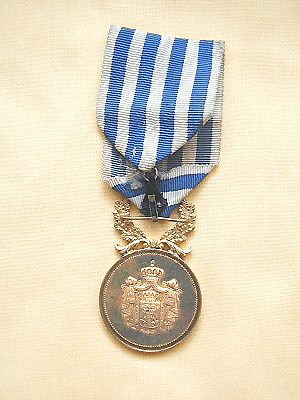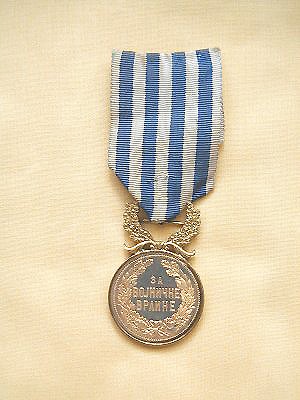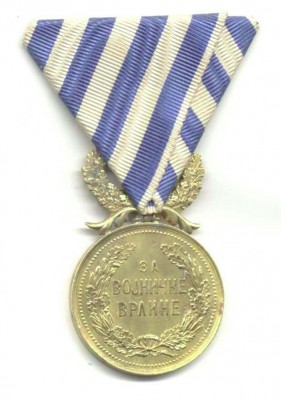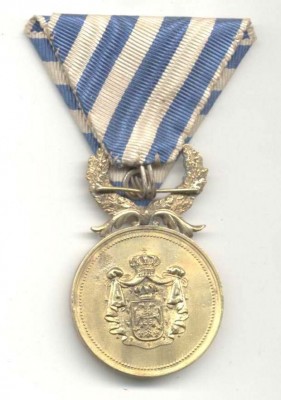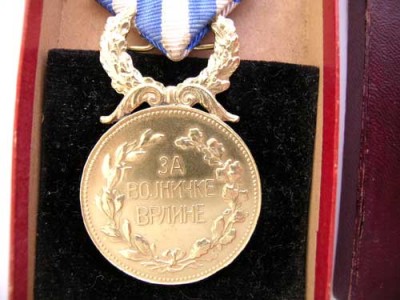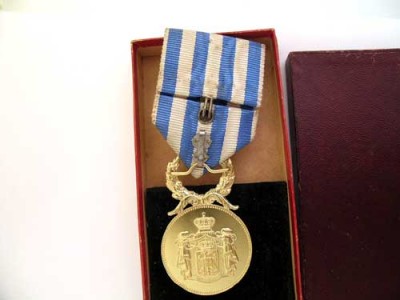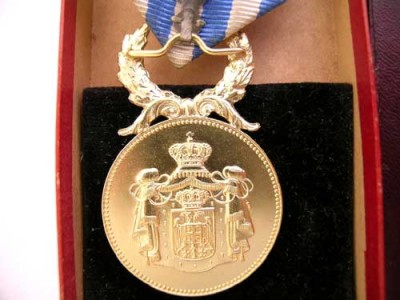| Název: Name: | Medaile za vojenské zásluhy | Military Merit Medal |
| Název v originále: Original Name: | Медаља за Војничке врлине | |
| Datum vzniku: Date of Establishment: | 21.12.1883 | |
| Datum zániku: Date of Termination: | DD.MM.1945 | |
| Struktura: Structure: | jeden stupeň | One Class |
| Poznámka: Note: | - | - |
| Zdroje: Sources: | Pavel Car, Tomislav Muhić : Serbian and Yugoslavian Orders and Decorations, Verlag Militaria | |
Medaile za vojenské zásluhy
Medal for military merit
Медаља за Војничке врлине
Reklama
This post has not been translated to English yet. Please use the TRANSLATE button above to see machine translation of this post.
Medaila bola zriadená na základe kráľovského dekrétu zo dňa 21. decembra 1883 v jedinej triede. Bola udeľovaná vojakom (či už v činnej službe alebo v zálohe) za "preukázané služby kráľovskej rodine a vlasti" ako aj za "vynikajúcu a vernú službu počas mieru, nebezpečia alebo vojny".
Medaila bola nosená na bielej náprsnej stuhe so štyrmi zvislými modrými pásikmi.
Zdroj: www.royalfamily.org
Foto: www.vitezmedals.co.uk
Medal for Military Virtues
This medal of merit had a firm place among the honours of Serbia from the time of its foundation until the dissolution of Royal Yugoslavia in 1941.
The conservative policies of King Milan Obrenovic in 1883 resulted in a government crisis. In 1882 the Principality of Serbia became a kingdom in 1885 Serbia lost the unnecessary war with Bulgaria both militarily and politically, but above all morally. The new constitution precisely defines the position of the army in society and its importance for the defence of the country. All these political, military and internal problems had an impact on the establishment of the new, modern "army" medal:
FOR MILITARY MERIT
A new state decoration designed to honour brave soldiers of the army is established by government decree (Collection of Laws and Decrees, XXIX, 302-303) of 21 December 1883. The decree specifies that the medal is intended for all army soldiers on active service, as well as for soldiers in reserve. In the justification, it was emphasized that it is a merit for the king and the homeland. The medal can be awarded both in war and peacetime. In Serbian society, this decoration was seen as a high award for service to the homeland and the royal house.
The medal is made of gilded bronze with a diameter of 35 mm. The 40 mm wide ribbon is white with four blue stripes. The medal is worn on the left side of the chest in front of all other medals of Serbia, SHS and Royal Yugoslavia.
The medal and its wearers were registered with the Royal Ordnance Office and there was a condition, the payment of a certain financial tax ( in justified cases it was forgiven). The first medal ceremony took place as early as 1884 (1. siječna 1884). the medal soon became very popular throughout society and its importance did not diminish even in the crisis years of the war and its demise in 1941 was also the demise of Royal Yugoslavia.
Thus, the medal took the highest place among the medals of merit. The Minister of War, Lieutenant General Jovan Petrovic, in his decree (10.veljača 1884) ordered or recommended that the medal should always be worn before the Medal of Valour, but before all other decorations.
The first specimens were minted by a company or mint which is not known to us exactly. By 1914, medals marked by Scheid and Christlbauer appear. After 1914 they are already renowned firms Arthus-Bertrand and Hugenin. The maker's mark is always at the bottom edge.
The medal was generally designed for a flowing ribbon, but medals also appear on triangular ribbons, which are not very nice in their form with a hinge for the flowing ribbon. So perhaps it was the Arthus-Berttrad company that produced several pieces of the medal that do not have a decorative classic hinge at the top, but only a spherical eyelet with a hinge allowing the medal to be worn on a triangular ribbon. Such a medal is known only from the collection of Zvonek Markovič.
The medal was awarded with a decree and we know of miniature versions of various design and quality.
The medal was always presented with an award decree, which, although it has changed in appearance over the years, is always a classic award decree confirming that the officer is entitled to visibly wear this meritorious decoration. On these decrees there is always the signature of the monarch, from Milan I, King of Serbia or a person in charge, but also from King Peter I. And very rarely we find a decree with the signature of the young King Peter II. On the decree we find stamps, stamps or dry seals.
Although medals are found quite often in our collections, it cannot be said that they are a common decoration. If the medal is with an award decree, we speak of a rare set.
Literature:
Pavel Car-Tomislav Muhič: Odlikovanja Srbije i Jugoslavije 1859 - 1941
This medal of merit had a firm place among the honours of Serbia from the time of its foundation until the dissolution of Royal Yugoslavia in 1941.
The conservative policies of King Milan Obrenovic in 1883 resulted in a government crisis. In 1882 the Principality of Serbia became a kingdom in 1885 Serbia lost the unnecessary war with Bulgaria both militarily and politically, but above all morally. The new constitution precisely defines the position of the army in society and its importance for the defence of the country. All these political, military and internal problems had an impact on the establishment of the new, modern "army" medal:
FOR MILITARY MERIT
A new state decoration designed to honour brave soldiers of the army is established by government decree (Collection of Laws and Decrees, XXIX, 302-303) of 21 December 1883. The decree specifies that the medal is intended for all army soldiers on active service, as well as for soldiers in reserve. In the justification, it was emphasized that it is a merit for the king and the homeland. The medal can be awarded both in war and peacetime. In Serbian society, this decoration was seen as a high award for service to the homeland and the royal house.
The medal is made of gilded bronze with a diameter of 35 mm. The 40 mm wide ribbon is white with four blue stripes. The medal is worn on the left side of the chest in front of all other medals of Serbia, SHS and Royal Yugoslavia.
The medal and its wearers were registered with the Royal Ordnance Office and there was a condition, the payment of a certain financial tax ( in justified cases it was forgiven). The first medal ceremony took place as early as 1884 (1. siječna 1884). the medal soon became very popular throughout society and its importance did not diminish even in the crisis years of the war and its demise in 1941 was also the demise of Royal Yugoslavia.
Thus, the medal took the highest place among the medals of merit. The Minister of War, Lieutenant General Jovan Petrovic, in his decree (10.veljača 1884) ordered or recommended that the medal should always be worn before the Medal of Valour, but before all other decorations.
The first specimens were minted by a company or mint which is not known to us exactly. By 1914, medals marked by Scheid and Christlbauer appear. After 1914 they are already renowned firms Arthus-Bertrand and Hugenin. The maker's mark is always at the bottom edge.
The medal was generally designed for a flowing ribbon, but medals also appear on triangular ribbons, which are not very nice in their form with a hinge for the flowing ribbon. So perhaps it was the Arthus-Berttrad company that produced several pieces of the medal that do not have a decorative classic hinge at the top, but only a spherical eyelet with a hinge allowing the medal to be worn on a triangular ribbon. Such a medal is known only from the collection of Zvonek Markovič.
The medal was awarded with a decree and we know of miniature versions of various design and quality.
The medal was always presented with an award decree, which, although it has changed in appearance over the years, is always a classic award decree confirming that the officer is entitled to visibly wear this meritorious decoration. On these decrees there is always the signature of the monarch, from Milan I, King of Serbia or a person in charge, but also from King Peter I. And very rarely we find a decree with the signature of the young King Peter II. On the decree we find stamps, stamps or dry seals.
Although medals are found quite often in our collections, it cannot be said that they are a common decoration. If the medal is with an award decree, we speak of a rare set.
Literature:
Pavel Car-Tomislav Muhič: Odlikovanja Srbije i Jugoslavije 1859 - 1941
Reklama
Join us
We believe that there are people with different interests and experiences who could contribute their knowledge and ideas. If you love military history and have experience in historical research, writing articles, editing text, moderating, creating images, graphics or videos, or simply have a desire to contribute to our unique system, you can join us and help us create content that will be interesting and beneficial to other readers.
Find out more